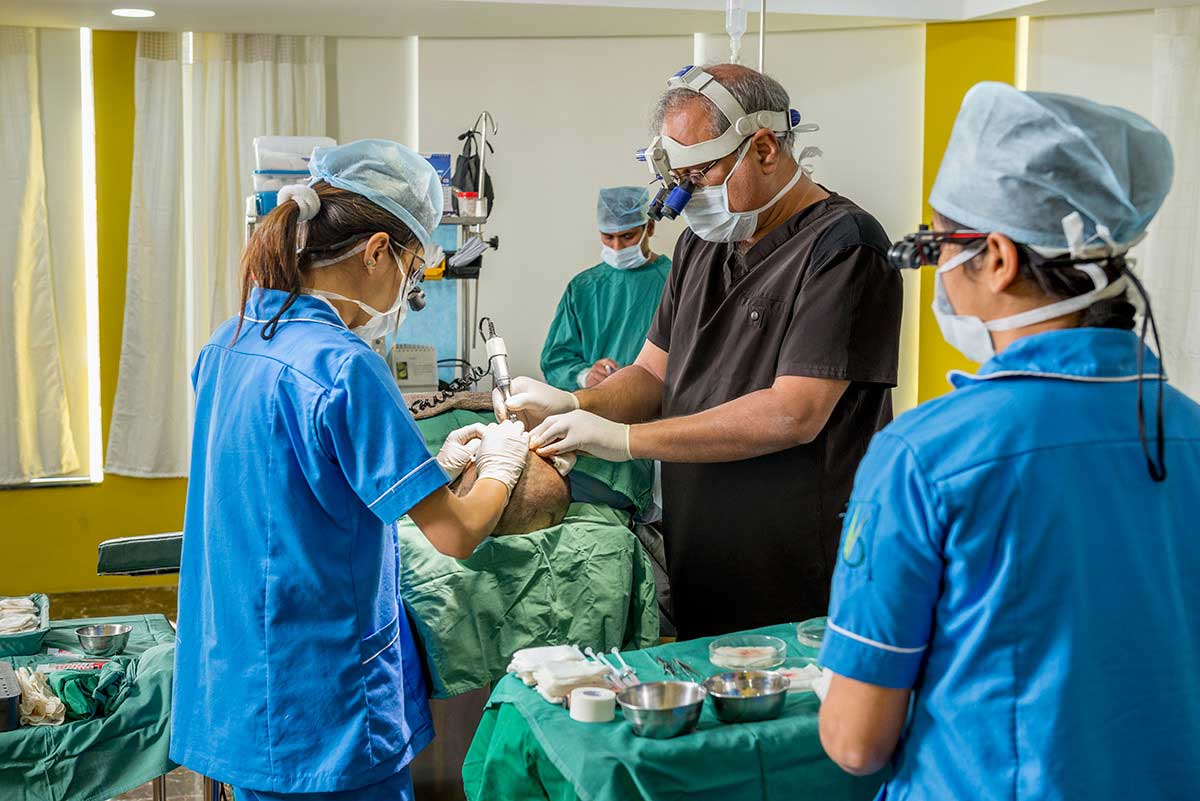Like in this result I am going to show you, where a Caucasian patient came seeking a touch-up four years later, I underline an important often ignored aspect of hair transplant.
Before I come to that, one of the most common trends I see with international patients is that they reach out not when they are on top of the world, enjoying the peak of their transplanted results, but when they find themselves rolling down the hill once again, facing the same hair loss struggles they had before the transplant.
They consider a hair transplant as an end unto itself—until hair loss strikes again!
This is why the golden phase, when the newly transplanted hair is at its thickest and fullest, is rarely documented by patients abroad. Instead, what I receive, often years later, are images of hair loss progression, showing the contrast between the stable transplanted hair and the diminishing native hair. This makes it challenging to display long-term Caucasian results on my channel, as the peak results are seldom shared, while the subsequent loss is emphasized.
See hair transplant results for Caucasians: https://www.youtube.com/playlist?list=PL369T6qyYsuGzUqqHgMAsICgekPq88_Et
Over a decade ago, a young Caucasian patient, 27 years of age at the time, walked into my clinic, eager and excited to undergo a hair transplant. Like many young men facing the emotional burden of hair loss, he saw a transplant as a definitive solution, a one-time intervention that would erase his baldness and restore his confidence indefinitely. What he didn’t fully grasp—and what I emphasize to every patient today—is that a hair transplant is not the end of a hair loss journey. It is merely a milestone, a means to an end, and the real work begins afterward.
This particular patient, despite achieving a successful transplant, was non-compliant with the recommended medical therapy, particularly finasteride. Not due to fear of side effects in his case, but out of a general reluctance to adhere to a regimen.
As I often stress, a hair transplant alone does not halt the progression of androgenetic alopecia; it only provides coverage in areas where hair is implanted. Without ongoing medical management, native hair continues to miniaturize and fall, leading to an unnatural look over time and necessitating further intervention. Stopping medical therapy is like pulling the plug on a well-lit room—you might not notice the darkness immediately, but soon enough, it will become impossible to ignore.
Vigilance + Compliance = Long-Term Success
A fundamental truth in hair restoration is that while a transplant moves hair follicles from a permanent zone to a balding one, it does not alter the genetic predisposition to hair loss. Patients who wish to maintain their results over the long term must follow a strict post-transplant protocol, which includes regular follow-ups, medical therapy, and lifestyle modifications.
See our Long-Term Results: Click!
For my patient, non-compliance with finasteride meant that while the transplanted hair remained, his native hair continued to thin, creating a stark contrast between the areas that had been transplanted and those that had not. The illusion of density was lost, and over time, he began to notice progressive baldness, particularly in the midscalp and crown. By the time he contacted me again, he was significantly balder than when he first walked into my clinic some years ago.
The Touch-Up Procedure: A Necessary Reinforcement
Given the extent of his progressive hair loss, my patient recently underwent a touch-up procedure, targeting areas that had thinned over the years. A touch-up or a second hair transplant is often necessary for patients who continue to experience hair loss post-transplant. While the first procedure lays the foundation, subsequent refinements ensure a more natural, seamless integration as the patient’s hair loss pattern evolves.
In his case, we reinforced the frontal region and worked on restoring density in the midscalp and crown. The goal was to blend the transplanted hair with the newly implanted follicles, creating a cohesive, youthful appearance. However, as always, the final results will take time—typically a year—to fully manifest. Rome wasn’t built in a day, and neither is a perfect hair restoration.
Patience is key.
A Hair Transplant Is a Commitment
This case underscores the importance of patient compliance and continued vigilance post-transplant.
A hair transplant is not a cure but a means to manage hair loss. It provides a permanent solution for the transplanted follicles but does not address the progressive nature of androgenetic alopecia. It’s like plugging a leak but ignoring the rising tide—you need a holistic approach.
Medical therapy is key. Whether it’s finasteride, minoxidil, or alternative treatments, ongoing management is necessary to maintain existing hair and prevent further loss. Think of it as daily brushing for dental hygiene—neglect it, and problems will arise.
Regular follow-ups matter. Patients should stay in touch with their surgeon, sharing progress photos not just when hair loss accelerates again but also during periods of optimal growth. A stitch in time saves nine—early intervention can prevent drastic measures later.
Touch-up procedures are common. As hair loss progresses, additional sessions may be required to maintain density and balance.
Lifestyle Changes
Patients should also consider lifestyle changes to optimize their hair health:
Nutrition: A balanced diet rich in vitamins and minerals
Stress Management:
Scalp Care:
Sleep and Hydration: Adequate sleep and staying hydrated
While this patient’s case is not unique, it serves as a potent reminder that a successful hair transplant requires long-term commitment and cooperation between doctor and patient. In another year, we will evaluate his touch-up results, but this time, he has a renewed understanding: a hair transplant is just the beginning of a lifelong journey in hair restoration.


